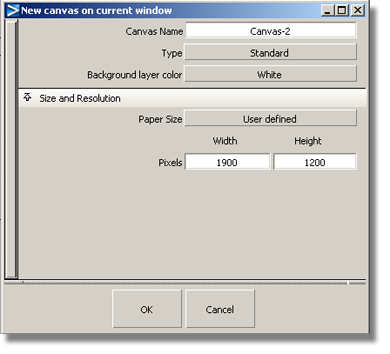Click the view you want to create a canvas plane on and choose Canvas > New Canvas .
.
You create a canvas plane for a specific view (for example, the Top view). Each view (Top, Left and Back) can contain several canvas planes.
If you select a brush and click in a view that does not contain a canvas plane, Alias automatically opens the New Canvas option box, prompting you to create a default canvas plane.
A single standard canvas plane can be created in the Perspective window this way.

The default Paper Size is set to User defined and lets you choose a width and height for the canvas (in pixels). If you choose Fit to screen instead, the resolution will be set automatically so that the canvas plane is sized to fit the view window. You can also choose a standard paper size (such as A4, B2, C0, etc) or Custom if you want to specify the true dimensions of your canvas (in world size units). For a description of all the options:
See Canvas > New Canvas .
.
In a Perspective window, you can also choose the Type of Canvas: Standard, or Overlay.
Overlay canvases are canvases that are only visible from a particular viewpoint. They are used in the perspective window to create perspective texture projections, 2D roughs, or for annotation (and bookmarks) purposes.
See Canvas > New Overlay Canvas .
.
Defaut canvases and overlay canvases created by using Canvas > New Overlay Canvas are the only two ways to create a canvas (and Paint window) in a perspective view.
You can also create a new canvas plane by importing an image file.
See Import an image as a new canvas.
Overlay canvases are always transparent (so you can’t see the canvas plane until you begin sketching on it). The default background color for a standard canvas plane is white in Paint mode, and transparent in Default mode. (This is the mode you chose when you launched Alias). This color can be changed through the Background layer color in the option box.
To change the background color of an existing canvas plane:
You can see the edges of a standard canvas plane if you adjust the view.
See Change your view of a canvas plane.
 .
.
A blank canvas plane containing one canvas layer and a background layer is created in the view you specified. The new canvas appears in a special Paint window, on top of the regular view window, ready for sketching.
To start a new painting session
If you chose the Paint workflow setting upon launching Alias, choosing File > New opens an option window allowing you to select the parameters (color, orientation, width, height, etc) for a new canvas. All other canvases are removed.
The new canvas appears in a special Paint window, on top of the regular view windows, ready for sketching, just as when using
Canvas > New Canvas .
.
See also Set up Alias for sketching.